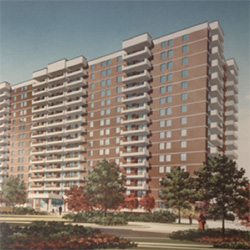If you live in multi-unit housing that already has a no-smoking policy, but there are neighbours smoking in their neighbouring units you can follow these steps:
- Make sure your landlord, property manager, condo board or service manager knows that no-smoking policies are enforceable. If approached, they might be glad to work with you to resolve the issue.
- Write a letter of complaint to your landlord, property manager, condo board or service manager. Written complaints will be taken more seriously than verbal ones and will also provide a paper trail if you end up taking further legal action to ensure a safe and smoke-free living environment.
- Try to block the smoke entering your unit by sealing up cracks and gaps. Ask the landlord, property manager, condo board or service manager to check the ventilation system to make sure that it is operating properly.
- Consider getting a letter from your doctor or healthcare practitioner stating the importance of avoiding exposure to second-hand smoke. If you have a health condition made worse by exposure, your doctor or healthcare practitioner can emphasize your particular need for smoke-free air. Share this medical letter with your landlord, property manager, condo board or service manager.
- Carefully document the problem. Keep a log with dates and times detailing every time smoke enters your unit, where it enters, how it affects you, and everything that you do to try to address the problem. This is vital—without sufficient documentation and other evidence, it can be difficult to prove that the second-hand smoke infiltrating your residence is an “unreasonable” disturbance that has resulted in a loss of your reasonable enjoyment.
Rentals:
If you live in multi-unit housing that already has a no-smoking policy, but there are neighbours smoking in their neighbouring units you can follow these steps:
- Make sure your landlord knows that no-smoking policies are enforceable. If approached, they might be glad to work with you to resolve the issue.
- Write a letter of complaint to your landlord. Written complaints will be taken more seriously than verbal ones and will also provide a paper trail if you end up taking your landlord to the Ontario Landlord and Tenant Board for dispute resolution to attain a safe and smoke-free living environment.
- Try to block the smoke entering your unit by sealing up cracks and gaps. Ask the landlord to check the ventilation system to make sure that it is operating properly.
- Consider getting a letter from your doctor or healthcare practitioner stating the importance of avoiding exposure to second-hand smoke. If you have a health condition made worse by exposure, your doctor or healthcare practitioner can emphasize your particular need for smoke-free air. Share this medical letter with your landlord.
- Carefully document the problem. Keep a log with dates and times detailing every time smoke enters your unit, where it enters, how it affects you, and everything that you do to try to address the problem. This is vital—without sufficient documentation and other evidence, it can be difficult to prove that the second-hand smoke infiltrating your residence is an “unreasonable” disturbance that has resulted in a loss of your reasonable enjoyment.






